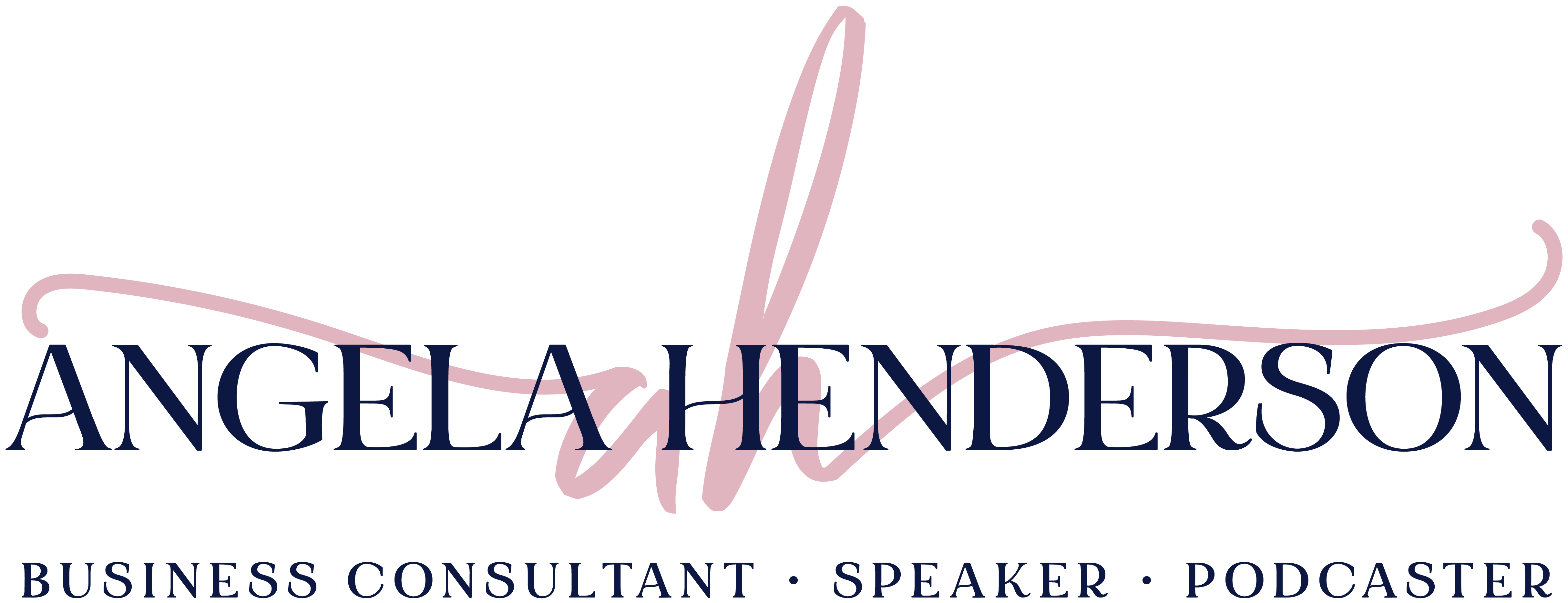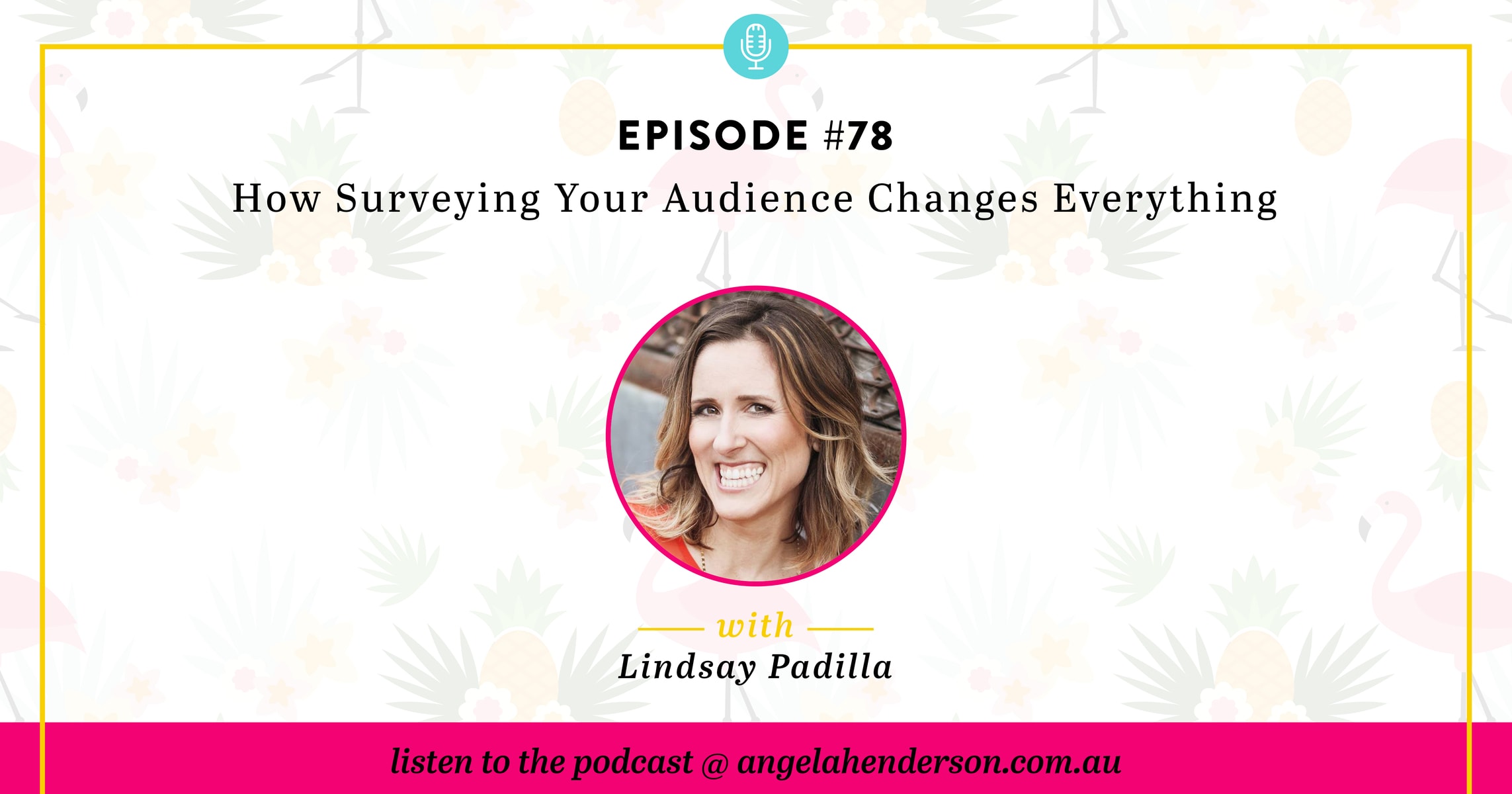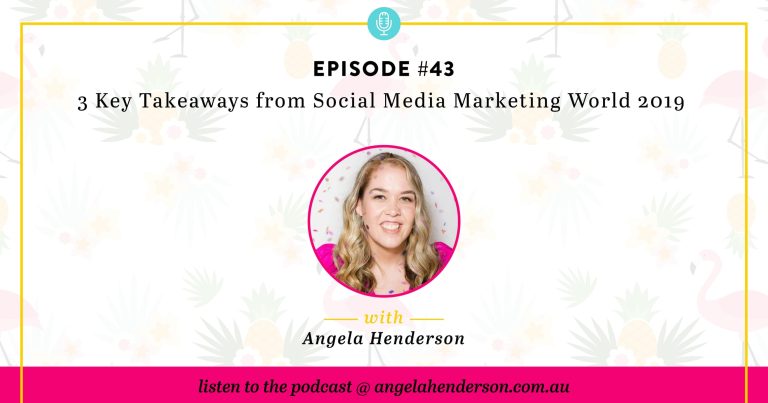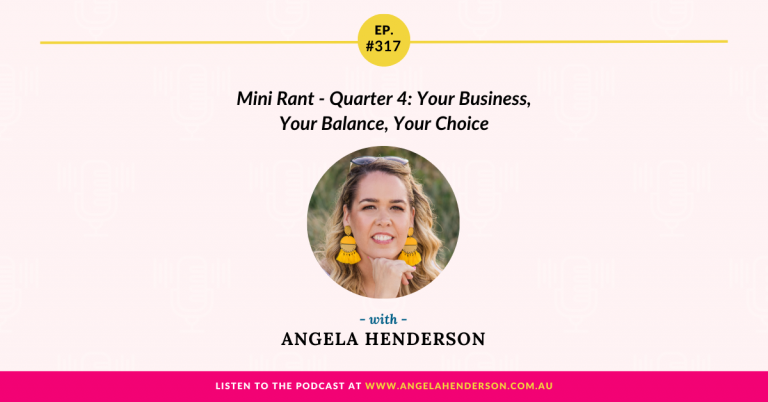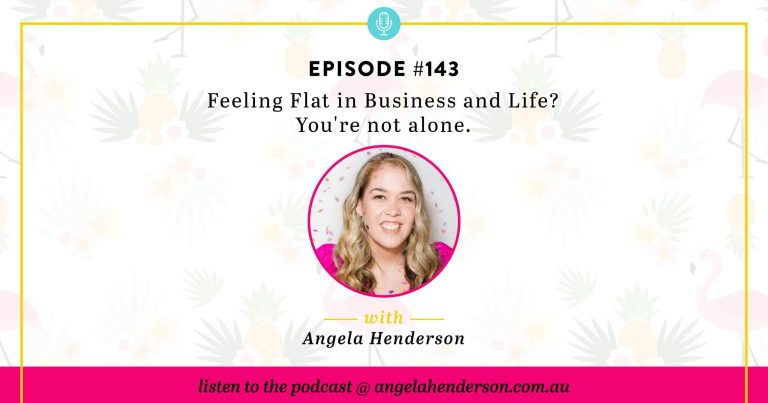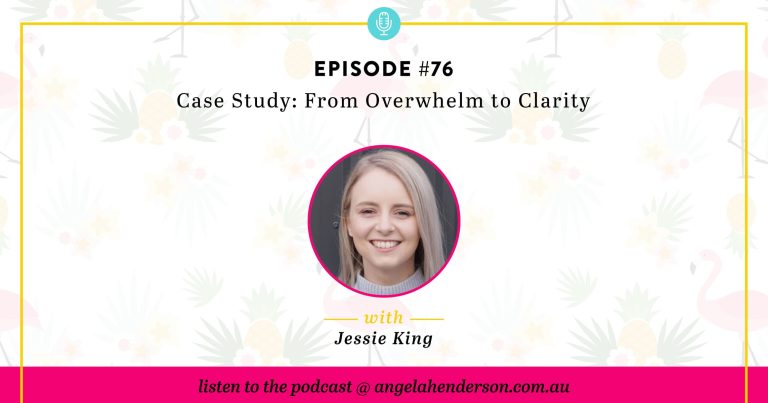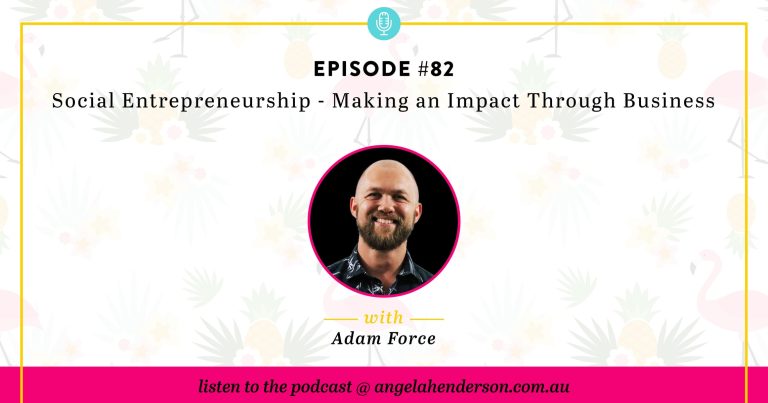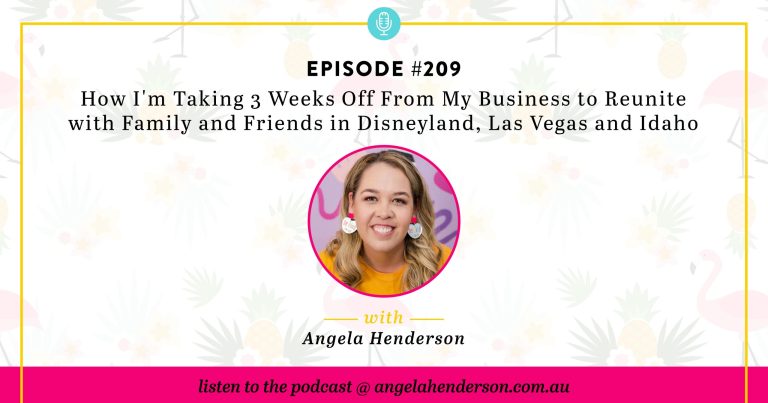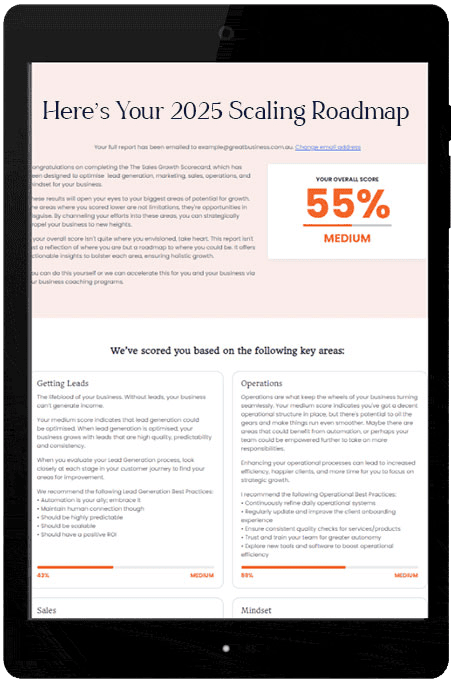One of the most powerful things you can do for your business is surveying your audience. And why is that so? It can help you uncover and learn about them to help you improve or create new products, courses, and programs for your business. My guest today, Lindsay Padilla, is going to share her expertise on the topic. If you’re looking to start surveying your own audience or wondering about the benefits of surveying or simply to know why you need it in your business, then you ought to listen to this awesome episode.
Important Links Mentioned in the Show:
The Teacher’s Lounge Facebook Group
Women in Business Retreat 2020
Angela Henderson Active Business Facebook Group
Angela Henderson Facebook Business Page
Prefer to read How Surveying Your Audience Changes Everything? Here’s the transcript:
ANGELA:
You’re listening to the Business and Life Conversations Podcast with Angela Henderson, Episode 78.
Hey there, you’re listening to the Business and Life Conversations Podcast. My name is Angela Henderson and on this show, we talk about improving your business, life or both, by having amazing and rich conversations with brilliant guests who will inspire you and who will give you tips and tricks to help you grow both in life and in business.
Well, hey there and welcome back to another awesome episode of the Business and Life Conversations Podcast. I am your host, Angela, from Angela Henderson Consulting where I’m a Business Consultant and Coach helping women in business go from stuck, overwhelmed and working in their business to helping them to gain clarity, the strategies and systems they need in order to allow them to grow 5, 6, and 7-figure businesses.
Surveying. Now today’s topic is all about surveying your audience. And it can be one of the most powerful things you can do for your business. What you uncover and learn about your audience through surveying can help to shape create new products, courses and programs, but it could equally help changing things up to make your products, services, programs even better from where they are today. Surveying your audience.
Now, I’m excited to bring on Lindsay Padilla who’s going to share with us her wisdom about all things surveys; why you need them, the benefits of them. She’s also going to share her framework on how you can start to survey your own audience and so much more. So get ready for an awesome episode.
But before we jump into this episode, I just want to let you know that this episode is sponsored by my new Business Master Class, The Ultimate 4-Step Framework for Creating a Sustainable and Profitable Business. In my 60-minute jam-packed, on-demand master class, you will learn my signature 4-step framework for creating a sustainable and profitable business without sacrificing time with your kids, without the overwhelm and without wasting any more cash. I also dig deep into the four big business mistakes that everyone in business makes and why they’re keeping you from growing a sustainable and profitable business. And lastly, I talk a little bit about what is working for businesses now and why most of what you’re being taught about growing a business is outdated and wrong.
To sign up for my on-demand master class, you can simply head to bit.ly/masterclasswithangelahenderson. Again, bit.ly/masterclasswithangelahenderson, and I’ll be sure to have that link in the show notes. Get ready for the show.
Welcome to the show, Lindsay.
LINDSAY:
Hi. Yey. I’m so excited to be here.
ANGELA:
It is awesome to have you here and I think there’s something to be said about the power of connections and just meeting new people face-to-face. And that is exactly kind of what happened with you and I is that we met a couple of months ago, early beginning of this year in March at a two-day master class summit with Caitlin Bacher. And from there, we’ve been able to hang out on social media, get to know each other a little bit, and then, yeah, you’re here. So what are your thoughts about, again, the power of investing? I know we’ll get into surveys and stuff, but I think that connections are so important.
LINDSAY:
Yeah, for sure. I 1000% agree. And if you remember, too, you were here in San Diego for Social Media Marketing World. So we shared amazing tacos and margaritas. And so, yeah, I think it really; I think something about getting in person with people just like advances the relationship a lot quicker. Like, it felt like when we jumped on the phone just now, it’s like, “Oh, yeah. Cool.” Like, we’ve hung out together, we’ve eaten together, we’ve shared a drink together, we’ve learned together. And so, it’s just like we’re just catching up, touching base and it just feels easier to show up for each other, I guess, when you know each other that well because you’ve met in person.
ANGELA:
Exactly right. And listen, we really have only really had a few little since March, like, “Oh, hi. How are you?” Like each other, so it hasn’t really been in-depth. But like you said, for the last 15 minutes we’ve been speaking what an exciting project you have coming up and it just seems that there was no barriers. It was just kind of like, “How are you?” Even when we were in San Diego and stuff, there were still so many other people we were connecting with, but again, we still have been able just to pick up where we left off and if you needed something or if I needed something, we’d help each other out.
LINDSAY:
Exactly.
ANGELA:
So I just think again, I’d start off the podcast with the power of connections, people, because this is how so many of my podcast guests come on board is through meeting face-to-face. Now, Lindsay, before we jump into the podcast, I always ask my guests a particular question; a little bit of fun question because I think it’s important that they get to know you as a person before we jump into the nitty-gritty about business.
So my first question is you did just mention San Diego; I know that this is where you live. And yes, we did have beautiful tacos and margaritas that night. So my question actually is what place in San Diego is the ultimate go-to dinner place that others who travel to San Diego need to go and check out?
LINDSAY:
That’s really funny. Yeah, so the restaurant, I have to suggest this exact restaurant because we actually take almost every person who visits us there because it’s so good. It’s called Lola 55 and it’s kind of like an artisanal coffee shop, mixed with cocktails and they have an excellent bar and cocktail menu as well. And they just have kind of cooked as you come in kind of as you order amazing tacos that are really, I don’t know, unique. And they have this fascinating flavours, and like, I don’t even know; they’re grilled cheese. Sorry, they’re quesadilla.
ANGELA:
Quesadilla, yup.
LINDSAY:
But their quesadilla that they make is unlike anything I’ve ever had in my life and I just get such joy watching other people eat it because it’s like a party in your mouth and it’s so good. Yeah, it’s really yummy. It’s over in East Village, which is, lots of people are familiar with the Gaslamp area of San Diego, which is very close to kind of the airport and everything. But it’s east of where you would see the Gaslamp District. So it’s just further away from the water a little bit and it’s a fantastic spot. Tell them I sent you once you’re over there.
ANGELA:
And I initially went with you and then I took some of the Aussies back there after the Social Media Marketing World. But the other thing is the tacos are so beautiful that the quality of the tacos for the price you pay is like, was crazy. I was like, they could be charging so much more.
LINDSAY:
I know, I know. And I mean, obviously, San Diego is known for Mexican food because I would also be the next person to tell you that any hole in the wall Mexican food place is going to be fantastic. But that’s like very traditional Mexican food. So this is just a little bit; a little bit of an edge, something different but tastes fantastic.
ANGELA:
Well, thank you for that. And yes, my stomach thanks you for that also when I was there in March. Now, listen. For those listeners who may not know you at all because we do get a lot of different guests and predominantly, my audience is here in Australia, can you tell them a little bit about who you are and what you do in business?
LINDSAY:
Yeah. So I’m an ex-professor turned entrepreneur; accidental entrepreneur. I thought that I would just start a business. I landed my dream job. I was on a ten-year track; I’m not sure what you guys call it over there. But, yeah, I was getting that amazing job at college and I accidentally stumbled into starting a business. Right now, our company is called Wealthy Teachers. I am partnered with my husband actually. I’m moving a little bit away from the personal brand and going into a larger kind of umbrella-type company, and in this company, we help entrepreneurs become teachers and teachers become entrepreneurs. And I just really want people to be able to teach better because when they can teach better, their students gets better results and that obviously can equal more enrollments in the future, which is such a wonderful thing when you’re in a course business.
ANGELA:
Yes, exactly right, because again, they say, as a course provider or as a coach, or anytime we are teaching people; and I can only assume for academics, too, in American universities is that the greatest win you can have is when you hear your own students relaying or sharing the information that was discussed.
LINDSAY:
Yup. Those ‘aha moments’ and yeah, I know a lot of people listening might be coaching right now or running group programs or maybe they’re selling products; digital or physical; and that moment when the consumer like just has this, “Oh my gosh. This changed my life,” or “Oh my gosh. I get it now. I never thought of it that way,” when I hear those words fall out of someone’s mouth, I’m like; “I’m doing my job.”
ANGELA:
Yup. 100%. And that’s like, well, I know when I hear it or see, I’m like, “Aha,” for myself. I’m like, my heart; I’m smiling; my heart is beating fast and I’m just happy for them because I also think that that’s my own perception is that as a coach, I’m there to guide you, nurture you and learn. But your success and failure will ultimately come down to how people take action. And so, I always see those people that the dots start to connect, the action starts to take and they just grow exponentially, so it’s always a good feeling.
LINDSAY:
For sure.
ANGELA:
Now as you touched upon; during your time helping entrepreneurs become teachers and teachers become entrepreneurs, you’ve worked with a lot of people around the world, not just in the United States. And while working with them, you found that one of the most important elements that people are missing in their business is that of also surveying your audience.
LINDSAY:
Correct.
ANGELA:
So for this particular episode, can you confirm what you mean by surveying your audience so that just we’re all on the same page?
LINDSAY:
Yeah, for sure. When I think of surveying, it’s kind of getting that two-way conversation open. And I think a lot of times, we can kind of put something out there and we’re like, “Okay. Cool. It’s done,” and then like watch the sales come in or not. But it’s a two-way conversation and if you don’t ask people either how awesome you’re doing or what you can improve, then you never iterate or you never change and make your thing better.
And I’m seeing that; I see that a lot in the space and there is really small incremental things that you could just be alerted to that you didn’t even realize because you asked, “How’s it going?” or “What’s your favourite thing that you learned today?” Anything like that and you will just start to see lots of places that you are doing amazing and places that you can really add value to your people.
ANGELA:
And for those that are; because I have individuals who are product-based businesses, but service-based businesses, some do group coaching, one-to-one, etc. Can you survey your audience depending on; doesn’t matter what type of business you have?
LINDSAY:
No, and we were kind of chatting about this. So obviously, I play in the space of courses a lot, but I do believe that the way I teach surveying and the way I want you to think about surveying your audience and I think; I also think when I hear surveying your audience, it’s like, sometimes they think of market research and I want us to also be thinking about how valuable the feedback from the people who currently are paying you is. That’s really important feedback.
Yes, market research is also really important. So those; I’m not going to talk a lot about that before they buy kind of thing where you’re asking like, “What do you need help with?” or “What is your biggest struggle?” That’s all important, too, but I’m kind of more ready to kind of talk about what we do when someone buys, they become a customer. That means that person raise their hand and is like, “I trust you. I bought your products because I think it’s going to solve our problem.” And you want to see how it’s going for them. And that’s going to be your key feedback; the key conversation you need to be having.
ANGELA:
But for the audience, but you can apply surveying your audience to people who are a product-based business, but also to those who are serviced-based.
LINDSAY:
Exactly.
ANGELA:
So really, any business can benefit from surveying their audience.
LINDSAY:
Yup. Correct.
ANGELA:
And for that, can you talk a little bit about what are some of the key benefits that businesses and entrepreneurs can get when they survey those audiences who are paying clients?
LINDSAY:
Yes. So I think the big one that I always taut I think as a teacher, it comes from the space of like listening to your students or listening to your people, right? And if you’re not ever asking, then you never really have the opportunity to listen as much as you think; like we can listen on some calls that we have or we can do a recording and we can maybe visit back the way most people don’t, right? But the power of the survey is another way, like kind of, sometimes, it can be anonymous and we can get into those kind of details.
But the idea that someone can sit and spend some time thinking about their experience with you and it can happen with their experience with the product, their experience in one-on-one coaching, their experience in a group program or in a course. They can actually give you feedback there and then you have to be the receiver of that feedback, and so that’s the listening piece. And I just think it creates a bigger connection because people; not only is it their feedback important, but the actual act of asking how are things going basically recreates that connection that they wanted with you in the first place.
And so, they’re like, “Oh, she’s paying attention to me. I’m not just a number. I’m not just someone who bought a thing. Like, she cares what I have to say.” And I think that’s really valuable because you’re really actually strengthening the relationship between you and the person who bought something from you.
ANGELA:
And I think that is important. I know when, in my own group coaching program, Profit Pillars, and also my one-to-one coaching, most of the women will start off by saying something like, “Thank you so much for asking me this,” or also “I haven’t really thought about that until now, but I appreciate that question.” So they’re quite grateful and come from a very positive space for the most part. But that’s the thing is I think also, sometimes people worry about surveying their audience because they may get bad feedback and they’re not in the headspace to receive.
Whereas the greatest lessons I’ve learned in time is through the negative feedback because I’ve been able to look in it myself. It’s not a reflection on them; it’s a reflection on myself as a course creator or a business coach. And I then have to start asking you better questions or I have to start doing things differently. So yeah, I think surveys are such a powerful thing. But I do know some people get a little bit reluctant because it’s hard for them to accept that information.
LINDSAY:
Yeah. I’d love to speak to that. So you guys might not have this; I guess it’s a website here in the States. But there is a website called ratemyprofessor.com; not sure if you guys have an Australian version. But we have a website that literally is anonymous things that students can write anything about any teacher at any college and any class that they take. And they rate you on like easiness; I don’t know; difficulty. They even like rate you on hotness rates, right?
ANGELA:
Oh my goodness.
LINDSAY:
So like, I taught in the era of ratemyprofessor and I survived. No, but like, the reality is like, and I say this a lot, too, at someone, because we actually had mandated end-of-course surveys that our students had to fill out and it’s always a big loophole in the United States as to whether or not like the college uses that against you if you get tenure and like should they make decisions based on student feedback and surveys.
So those kinds of surveys are, yeah, sometimes you can notice some trends in your own work and you can look back and say, “What is it about them feeling that they’re not getting X result? Or that they didn’t understand this concept.” And it is difficult as a teacher to hear like, “Oh, crap. Like, I’m not serving them.” And I think it’s even scarier when there’s money tied to it because I’ll say, at the college level, “I’m like cool. Like, I can improve my teaching, but this is like, someone gave me $1000; like, I better help them,” right? Like, there’s some kind of a judgment, at least for me as someone who’s from institutions to like online.
But the criticisms, I’ll also add, sometimes it is a reflection of the student. And I actually do talk about this with my students that sometimes you can have a student who’s in a bad headspace as they’re filling out the survey. And they’re blaming you for things that you might not be responsible for. And you can usually point out or tell in a survey if someone’s in that area because everything they say is laced with that like, “But I didn’t get this or I didn’t do that.”
ANGELA:
Totally.
LINDSAY:
So there’s little things here and there that I would point to if you’re reading a bunch of feedback and there are criticisms. And I’ll say this, too; there can be one student out of a hundred in a semester, but you’re so worried about that one person who said that one thing and I think volume is a big piece of this. If it is just one thing, you get to decide as the educator because it’s your ship, it’s your course; you get to decide, “Is this actually something that will help future students? And are they pointing out something that I could change? Or are they coming from their own problems that they’re dealing with internally?”
And so, the same way we process how other people react or does, right? And all that lovely stuff we can talk about with relationships and stuff. It’s like; it’s related here, too. So you get to decide what to leave aside and you get to decide what will actually serve future versions of your course and your products that you have. So I do like to say like everyone will get critiques. There’s no way to do it perfectly and often, the critiques can come from a place of like, “Well, maybe that person is just, in general, not thinking about it in the right way.”
And I’ll say, too, like, without going into a bunch of details about like how I survey people in courses, if you survey people in the beginning of the course, at every stage of the course, like every module, and at the exit of the course, you’re going to have actually less really negative feedback. You’ll get these great things were students will be like, “Oh, I loved this module,” right? Because you asked them a question, “What was your biggest aha?” And they’ll be like, “Oh my gosh. I never thought about X this way.” Then you ask them, “What was something that was confusing or what do you wish I covered?”
We just read through all of ours actually. We’ve had about 400 students go through our product and we just went through all the survey feedback. I’m currently in the updating my course phase myself and there was nothing that made my heart dropped; nothing, not a single one word like, “Oh my God. That person hates me.” It was all amazing and constructive and I’m like, “Yup. I’ve heard that three times. They’re absolutely right.”
And so, you can get yourself in that headspace if it’s specific. When you just survey at the end of a product, at the end of a coaching experience, at the end of a group-like experience, a lot of times, the students are just reflecting on what they mostly recently remember. And so, if it’s been 6 months, they might just be like, “Yeah, I got the result, Angela. It was amazing,” and like, “Oh, I really liked this topic,” and then they’re like, “Okay.” Like, they’re not going to be like, “Oh, when Angela was explaining that one tiny thing, I didn’t get it.” They’re not going to say that because they don’t actually remember. And so, I think it’s really important that that the better you get at surveying, the less likely you’re going to have feedback that makes you like nervous; if that makes sense.
ANGELA:
100%. And I also think that, too, because you’ve had multiple touchpoints. You’ve shown multiple times that you care about them.
LINDSAY:
Correct.
ANGELA:
And that you value their opinion and that you’re willing to make things better. Where I think that last kind of survey just kind of like a token as they, “Oh, well. They’re doing this because they have to do this, right?”
LINDSAY:
Yeah, like she wants a testimonial, right? Or something like that. Yeah.
ANGELA:
Totally. Whereas, if you kind of make it part of your culture of that process from beginning to end, then it’s become part of the norm. “Oh, yup. They’re just surveying because they want to see where we’re at or whatever.” Like, they’re used to it, right?
LINDSAY:
You’re bringing up a point, too, that I want to drive home and I know we already said it, but it’s coming back. This is coming back full circle is surveying is not just about like what can I take from my audience. I want to take these answers or I want them to tell me who they are so I can be able to find my ideal client, right? This is about relationships, like surveys can actually go both ways. They’re going to see value in you asking and like seeing them and that you’re listening.
And I think to close the loop with surveys just to be clear, then you have to go implement it, right? Like, if you ever ask all day, you better have some process in place or carve out some time in your business to actually go, “Okay. Now, let’s make some of the changes people suggested.” And I’ll say, that’s easier said than done. It’s not easy to sit down and keep reiterating and improving a product that’s already doing pretty well, but it’s going to be great and you want it to be great because that greatness is what actually sets you apart from other people who maybe teach or coach on similar things.
ANGELA:
Yup. 100%. And like, I love the fact about the relationships because I know there are some people out there who will teach to super automate or to bring a lot of team members. And then, I believe there’s a time and place for automation. I also believe there’s a time and place to bring staff or other people in, right? But I also think that when people buy from me, I don’t have to be the end all be all. They can still get answers from their community etc., but they’re still buying my course because it’s Angela Henderson’s course.
So to me, relationships are super important and that’s one of the primary feedback I get in both my group and one-to-one, is like, I actually show up. I don’t just to the course and ear drop and run, right? And that’s probably another podcast episode.
LINDSAY:
Yes, another episode, but it’s related. And recognizing that this kind of surveys, by putting them in place, they can be automated, right? And like, we can automate that, but you open the door, so if someone gets a 90-day progress write a survey, then you’ve officially opened the door in your email to let them be like, “Oh, thanks for sending this. I’m so glad you made me look at this.” And again, it’s that touchpoint. So it’s not just this one way I’m taking information, you’re actually opening the door back to your consumer and customer or student or whatever you want to call them.
ANGELA:
But I also think it also helps with giving the consumer the responsibility for their own outcome for a course, also.
LINDSAY:
Correct.
ANGELA:
That if you start at the beginning, and we’ll talk about the framework that you kind of use in a minute, but if you think about it or if you open up that dialogue at the beginning, in some of your questions, you can also frame them around about like how much time are you dedicating, what are you doing for this, etc. etc. And that the ownership, their success and failure isn’t a direct result of you and your program, but actually, it’s also the direct result of how much time, effort and willingness that they’re going to take to ask questions, be involved in the group and seek that help and assistance. So I also think you kind of pre-seed what their outcomes potentially can look like based on those part of that survey.
LINDSAY:
Yeah. And I can get super nerdy and talk about like adult learning theory and like reflecting on your learning, but what you’re bringing up is exactly that. If you don’t ask them, “Hey, how confident are you around X topic?” And they rate themselves. If you never ask that, they might just be like, “Oh, I’m not that good.” And then, it’s like they have to reflect and assess themselves because we’re not giving essays and exams and stuff like that.
So we have to ask them to reflect on where they’ve been, where they want to go because that’s the thing that you can use when you’re coaching and teaching to say like, “Wow. Look at how far you’ve come.” So then, at the end of the experience, a student is like, “Yes, Angela got me from here to here and I can see this growth because I was asked about it. It wasn’t just about watching videos.”
ANGELA:
Totally. 100%. Now, so for those of you out there that are like, “Okay. I probably have zero surveying in my business structure at all and I need to kind of up my game.” Do you have a particular framework or do you have particular steps you can walk the listeners through about…
LINDSAY:
Yeah. I have a couple of steps. The first step is when you’re sitting down to go like, “Okay. How can I add this kind of stuff to my business? How can I use surveys to converse with my audience?” The first question you want to ask yourself is like, “What am I using this for in my business?” So that decision, there’s going to be multiple surveys of likely, as Angela and I are kind of going back and forth, there’s lots of places you can use surveys in your business. And so, you just want to ask like, “What is the intention behind this?”
So for example, surveys that are in a course, the intention behind it might be, “I need to know if my students are understanding the material. “Okay? That’s a very specific type of intention. Another might be though, because different surveys also can have multiple questions in there that are related to the intention. But you can totally do some market research and some ideal client research when they come in our course. Like, how much money are they making per month? Like, who’s on their team? How many years in business? Like those kind of; well, I wouldn’t say generic questions but like demographic-type questions that’s going to help you as a business owner be like, “Well, I served this group really well.” Right?
So market research is totally allowed on the inside of a course, but I just want to make sure you’re also thinking about progress and students getting results. And then, there’s other surveys in your business, other intentions could be learning about who’s on your list, learning about what help they need when they download a specific freebie, right? Those kind of surveys, and I put them on air quotes because sometimes, it can just be in an email and you don’t even have to overthink it. It’s just, ask a question. We don’t really have to get complicated.
But, yeah. So the first step is thinking about what is the intention in your business for this particular survey and just start to think about what kind of goals you want to accomplish with the survey.
ANGELA:
Fantastic. And for those people who are like, okay, they’ve gone, “Great. I don’t have surveys. I now know that I need to survey them and this is my intention from having them,” like you talked about, are there particulars tools or platforms that you recommend for businesses when the survey their audience?
LINDSAY:
Yeah, you know, there’s a couple of things here and I can get super like nerdy with tech. I like playing with shiny objects, like this tech piece will save my life. You can get super basic and keep it in Google forms and not make anything crazy complicated. We actually just did a Google form for something; I can’t remember because I was working on it with my team. But default for us? Oh, it was for hiring, actually.
But default for us is Typeform. I just like; it’s just pretty, it just looks pretty. I like the way it setup. It actually embeds really nice inter-course platforms, and so, that the student does not have to like exit or leaves. So does Google forms, but that’s pretty [Crosstalk 00:27:27]. You could do some decent stuff on Typeform for free. They do start to charge I think when you get over 10 questions. And so, I think they just capped that, so you might want to go with something like Google doesn’t do any of those kind of caps.
So Typeform and Google are my typical ones. I know there’s some interesting kind of quiz-based software that is coming out and nothing that I would definitely recommend to the audience because it’s one of those things that it does some cool stuff, but it’s not as basic an entry-level as I would like it to be for me to recommend.
ANGELA:
Fantastic. And also, like you said, sometimes, you might just have one or two questions, so there’s no problem also with, like you said, not overthinking it. And if you send like just an email to your email list, and have either you or a team member, staff member, collect that data and present it to you. So again, for those of you like, “Oh, great. Another tool I have to pay for or whatever,” like you said, Typeform lets you do some stuff without having to pay. Google Forms is free. You’ve got your email if you’re already using it free.
Like, you don’t have to go, I think again, people use that as a blockage to actually go on something. Much better, I’m sure Lindsay would say the same; use your free resources that you already have and start surveying and gather that rich, juicy data so you can make your products or your courses or etc. better than what they already are.
LINDSAY:
Yeah.
ANGELA:
And so, how often, obviously do you think surveying your audience and how the frequency depends on what they have. So for example, if you’re an e-commerce, obviously, you might only get one customer one time or you could get returned customers etc. But you could, so in that instance, you might survey them once and it could be post-purchase, but for something in a course, I know you recommend kind of; there’s kind of multiple touchpoints that we’ve just talked about for the beginning, middle and end. But is there like; do you have any other reason or do you think that’s kind of like how the flow should go? Or do you just kind of just test, test and test some more?
LINDSAY:
I’m always a fan of testing; always a fan. And I think what you want to be thinking about if you go back to that notion of like ask yourself what the intention is, if one of your intentions is to improve the product, then you like improve the learning experience and that they’re actually learning the materials, that’s a goal of yours, then you’re going to be like, “Wait, when is the best time to ask them what they learned and how the learning is?” It’s like, it’s right when they watch it. It’s not five months later. So I think you can loop it back or like circle it back to the intention.
And you could argue, I’ve never owned any e-commerce business, so you might be better at thinking about how it ties in there. But you can ask for feedback about the product is, you can ask for, obviously, those reviews, which everyone loves. But you could also ask about like, “How likely are you to recommend this to a friend?” Like, “How likely would you buy this for someone for Christmas or an event?” Right?
And so, you can survey and get to know your people more and not again could be, like it could be months after they buy the product and unrelated to link of time, you’re just checking in to see how they’re using your product. And I think that would reveal a lot of things for someone in e-comm, the e-comm space. And so, I think it is thinking back to that idea of intention because the number of times you ask, when you ask, and how you ask is probably related to an intention.
ANGELA:
Fantastic. No, surveying. I can’t emphasize enough the importance of again, having this conversation and that the listeners, again, my whole podcast is always about just planting the seed, getting them there. Some people, you might not be ready to embrace the survey yet, but I really encourage you to keep it on your to-do list and start looking at little ways you could integrate it. Again, you might be having a course and you’re like, “Shit, how do I do the beginning, the middle and the end?” Well, maybe you choose one and really hone in on that, and then add the second later and the third later.
Like, I think there’s different ways, but it is so important to gather this information because it’s really going to help stem the growth of that course, that product line and just your overall sustainability and profitability within your business.
LINDSAY:
Yeah. We’ve got to use data-driven strategies to make decisions on our business, right? Because some people think like, “Oh, I should just read you my entire course,” and it’s like, “Is there evidence that you need to do that?” So yeah, you need to collect that data.
ANGELA:
And I’m a huge numbers-person with my clients also. I think it’s important that again, sometimes we put these blocks in our mind that it’s one thing. But then, like you said, you go back to the data and you’re like, “Actually, no. This actually doing really well.” So yeah, totally data-driven. Now for those businesses that would like to connect with you and find out more, where can they do so?
LINDSAY:
Yeah. I do have a free Facebook group that I love and I teach a lot in there. We talk a lot about teaching. It’s called The Teacher’s Lounge; that’s a fun place that you can meet people in my community and learn a little more from me. And then, I just really like hanging out on Instagram. It’s just; I do Instagram stories. I’m not super good on the feed yet, but Instagram stories, want to take a peek in the behind the scenes…
ANGELA:
One step at a time.
LINDSAY:
Yeah, exactly. That’s where I enjoy being social right now.
ANGELA:
And what is the handle for Instagram?
LINDSAY:
Yeah. Handle for Instagram is @drlindsaypadilla. And The Teacher’s Lounge, I think you could just search in Facebook and it should come up.
ANGELA:
Yeah, and we’ll add those links in the show notes and on my web. One final question, what do you know now that you wish you knew when you first started off in business?
LINDSAY:
That there is no such thing as failing but learning as you go. And I think as an academic, that’s been hard for me to let go of, but now I get it. And so, I wish I failed harder and faster earlier in my business.
ANGELA:
Yeah, totally. I talk about this often on the podcast that people look at and they really beat themselves up about “mistakes” or failures. But I genuinely believe their the lessons that we need to get us to the next step in business. And people can embrace that and go, yeah. I look at for example the lessons of we’ve just spent quite a bit of money on Facebook ads the last month and some people are like, “Oh my God. You’ve spent that much money and you did this,” but I’m like, two/three years ago, I would have been having heart failure, right?
But now, I’m like, I can go back and I can look at that data and what do they most connect with and where can we change and pivot this, and was it just the US audience, was it the Australian audience? Like, that data now is actually, yes, it’s a copious amount of money, but what we’ll take from that will be what we need to get us to the next step and we don’t make those same “mistakes” again. Because I believe if you don’t look at the lessons that you need to learn, that’s when the mistakes will just keep happening because someone in the universe is trying to tell you, you haven’t quite got the lesson yet to look forward.
LINDSAY:
Yeah. And then I think it makes us feel bad. Like that’s my whole thing, too, is like we need to hang on to as much confidence that we can as entrepreneurs because that’s the thing that keeps us going. And if we’re like letting something eat us away, it’s like, if we don’t have actually any evidence that that’s really what’s happening, it can drag you down. And I think that’s what happened to me. And that’s why it’s like, you look at the numbers, you look at the data, and then you can say, “Oh, this is what’s happening. It’s not “all my fault.” Easy to get there; easy.
ANGELA:
And again, that’s mindset and that’s a whole other conversation.
LINDSAY:
Yup.
ANGELA:
So listen, before we sign off, also just to remind for everyone that’s listening, my team and I will also be putting together the whole transcription for this episode at angelahenderson.com.au. And of course, I cover all sorts of related business and life topics inside my very active Facebook community, The Australian Business Collaborative. So make sure you head on over and join. But for the rest of you, have a fabulous day no matter where you are in the world and I look forward to you joining me next week for another amazing episode of the Business and Life Conversations Podcast. Thanks again, Lindsay, for tuning in from San Diego. I appreciate it.
LINDSAY:
Of course. Thank you.
ANGELA:
Thanks for listening to the Business and Life Conversations Podcast with Angela Henderson, Surveying Your Audience. www.angelahenderson.com.au
